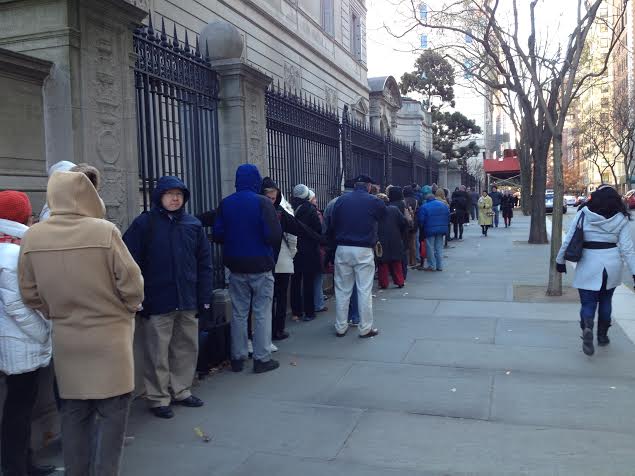Four Vermeers all at once

Intrepid art lovers properly attired outside the Frick, in 20 degree chill with 40 mph gusts of wind. Some waited an hour.
More than ten percent of all 34 (maybe 35) Vermeers in existence are on view right now at The Frick. It’s a little show, a tour of 15 paintings from the Dutch Golden Age, on loan from The Hague, yet it’s a powerful and enlightening one. I’ve seen about half of all Vermeers in the world. The Metropolitan offered 15 of them in 2001 and then The Milkmaid, all by her ownself, in 2009. So, yeah, maybe I could have skipped this one. I hear that. But this show taught me a thing or two, or three, about Hals and Rembrandt, and introduced me to Jan Steen, whose work felt the most contemporary, out of everything in the show. Plus the goldfinch Donna Tartt is making famous at the moment. Most of all, though, when you surround this show with The Frick’s permanent collection, it’s a rare chance to see four Vermeers at once, and it’s a truth universally acknowledged that one can never get too much of Vermeer. The Girl with a Pearl Earring has a room all to herself, as The Milkmaid did. In the room adjacent are the three from the permanent collection. I hope to write at more length about what I saw here when the necessity of word smithing for my supper lightens up, if ever.
I stood in line for 40 minutes with at least 60 other shivering and likemindedly unhinged art lovers last week, with temperatures around 20 in New York City, and 40 mph gusts driving wind chills down to around zero. With my typical worldly foresight, I wore a wool sweater covered with a fleece, clothing options that should have sentenced me to the fate of this frog. But to my credit I thought to climb into some thermal underwear at the last minute before my friends and I headed into the city from New Jersey. ( I’d brought the underwear in case I decided on an outdoor run in the morning.) It felt as if those skivvies saved my ass, as well as a few other more expendable parts. Bottom line: the show was worth the painful wait. What did we learn this week? Most of that, that even old, old art, if it’s great, still draws crowds that require scheduled admission into a museum. Give the human race a chance, and it will always make you believe that what once mattered still matters. Makes me want to paint, right?
I saw Girl with a Pearl Earring in San Francisco this summer or maybe spring. … She was with a bunch of Dutch paintings – mostly from the De Young collection. In a room alone in the dark and very lovely. He makes it look easy.
It was accompanied by Rembrandt’s Age – or some title like that – Dutch prints. That overall show was one of my favorites ever, surprisingly. The technical ability of the prints were stunning and that was fun but it served to point out why Rembrandt is so great- His prints were sketchy, messy but emotionally true and deep. Humanity in all his stories.
Makes me want to paint too.
Nobody’s better than Vermeer. I’m going to do another post if I can about the documentary “Tim’s Vermeer” that follows a guy who basically recreates a scene from one of Vermeer’s paintings and then tries to reproduce it using lenses and mirrors as a guide. I’ve been reading about it and I think it’s being marketed, in part, as a debunking of Vermeer’s “genius”. It takes this fellow months I think to do a “forgery” to his own satisfaction, but the labor involved, even using what were essentially photographic tools says a lot about what Vermeer achieved. What always strikes me about his paintings was how his level of detail is utterly persuasive but also carefully limited. He only reproduced what he saw up to a certain point. He’s always getting the paint to evoke things it isn’t really showing you, so that you see more clarity and definition that’s actually there. Maybe that’s partly a function of the camera obscura. If you compare his paintings to something by a hyper-realist now, Vermeer almost looks, by comparison, like the work of an Impressionist. Compare View of Delft to something by Canaletto. Canaletto was insanely detailed in his scenes. What’s impressive about Vermeer isn’t just what’s there, but what he leaves out and how he generalizes an area of color. On the other hand, there are those maps! Yikes. Like a photographer, it was as much about he staged the scenes he chose to paint: the best ones are full of so many things and yet look utterly simple because of the composition, the quality of the light and the color.
The Rembrandts I found most amazing in this show were ones where he was able to evoke an amazing range of expression and drama from the faces and bodies of people in a scene–where the figures took up only a few square inches of the canvas. All of it suggested rather than precisely rendered. It’s hard to imagine he wasn’t startled and amazed at what he was able to do as he did it.